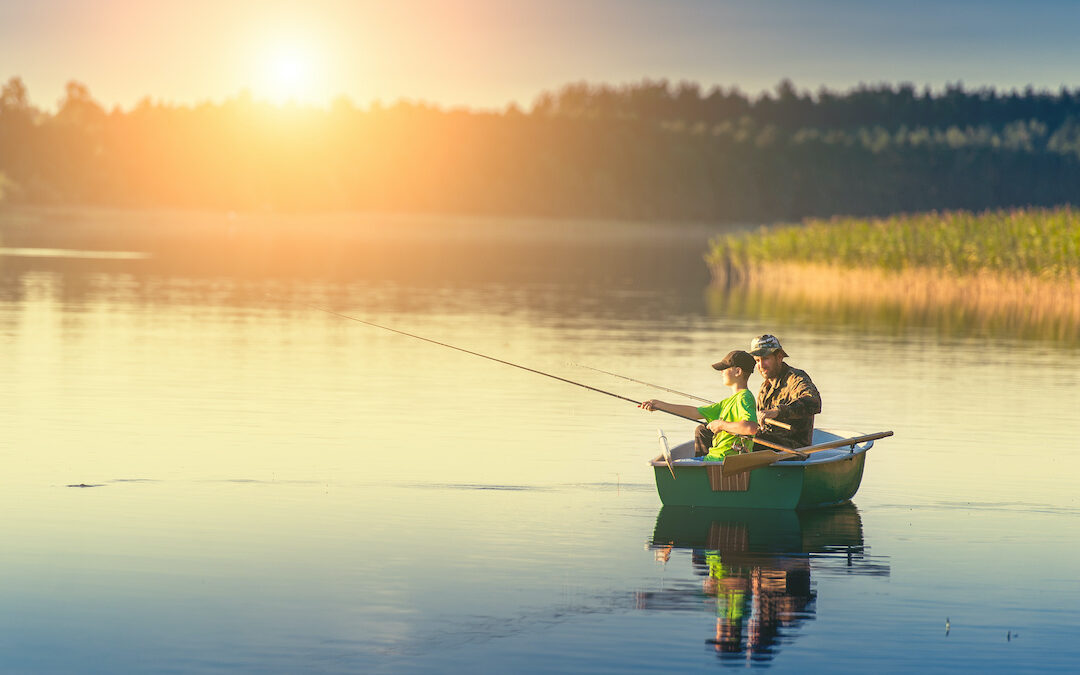Seeing families out on the first day of fishing season left me hopeful about our relationship as humans to the natural world — despite a very challenging reality. There is still so much beauty and love to be found in our relationship to nature.
The boy turned and smiled as he told me about the fish he’d just caught. A cute kid, about seven, with a wide, toothy grin, freckles and ears he’ll grow into. He and a woman, presumably his mom, wore rubber boots and had just loaded fishing poles and a net into their car. I passed them near the lake at Pennsylvania’s Greenwood Furnace State Park.
Celebration was in the air. Parents brought their children to the lake that morning on the first Saturday of April to fish on Opening Day of Trout Season. Just after 10 a.m., two hours in, I asked him if he caught a fish.
Yes, he answered, beaming.
A salmon, I think? he said.
No, said his mom, a trout! You caught a TROUT!
She chuckled and tousled his hair with her hand. Get in the car, she nudged.
It’s OK, I called out, smiling, as we walked on. You’ll learn the names!
Off they went. On I walked with our dogs past the picnic pavilions and toward the campground, feeling lighter and more hopeful after sharing that thrill of reeling in a fish.
A beautiful moment of a child enjoying an exciting connection with the natural world.
A reminder that despite the challenging reality, an urgent need for humans to find balance with nature, there is still so much beauty, love and comfort to be found in our relationship to nature.
‘Guiding Lights’
Maybe this little boy will always remember catching that trout, the way I remember exploring the woods as a kid or turning over rocks near Tinker’s Creek. No single moment like this saves the world — and yet, they all matter because they can help us heal our collective relationship with nature.
These memories are “calling cards to the wholeness of a human lifetime, strongly rooted in your nature,” write social-psychologist Mary Clare and science writer Gary Ferguson in their new book “Full Ecology, Repairing Our Relationship with the Natural World.”
Their book begins with a photo of Mary Clare as a little girl, standing with her sister in a pond with water up to her shins, looking for tadpoles, then a picture of Gary Ferguson as a kid standing on the sandy shoreline of Lake Michigan feeding seagulls with his dad and brother as waves roll toward them.
“Guiding lights showing the way back to the landscape of your being. A homecoming, as uncomplicated and mysterious as tadpoles in an alpine pond or seagulls dancing above the dunes,” they write.
Everything is Better Outside
My love affair with the natural world began as a kid at the shallow Tinker’s Creek, near Cleveland, where I learned everything is better outside, among the trees and the sound of water moving over rock.
My mom would pack up eggs, milk, cinnamon and bread, and kitchen gear. We’d unpack at a picnic table between the creek and the woods in one of Cleveland’s Metroparks — an emerald network of wild places and natural gems that offer escapes from the housing developments and strip malls of suburbia.
She’d start a charcoal fire in the grill, then mix up the batter, soak the bread and cook a French toast breakfast for us on the griddle.
We’d pick our way along the creek, turning over rocks — even though I don’t remember much except feeling squeamish about what we might find. The joy was in the looking.
We’d walk the trail through the woods to climb a big boulder.
Later, when I was in college and it was time for me to figure out where to live next, we walked together in the forest in New Hampshire’s White Mountains. On that trip, I realized people could live within big, wild, natural places — where the forest or the mountain or the sea was a constant, dominating presence more powerful than freeways and parking lots and shopping malls. I wanted that life. An innkeeper in the mountains. A whitewater river guide. A farmer. A fisherman. A writer.
First Assignment: Heartbreaking Loss
I chose Maine for the water. Almost every turn on my first drive in Maine took me to a lake or river and eventually the ocean. Soon, I had my first pro-writer job.
The newspaper editor pointed to these squiggles on the map: crooked fingers of a peninsula and chain of islands and said: These are your new stomping grounds. These fishing villages. That’s your beat.
Maine fishermen are a skeptical bunch, and I was “from away.” So it took some time for my genuine curiosity to wear away our cultural gap.
But it did.
Telling their stories was an honor. The iconic cod stocks off the New England coast, so key to colonial America, were crashing and no one really fully understood why. The scientists said it was too much fishing. The fishermen said the scientists didn’t know where to look for fish.
Turns out Atlantic cod is likely one of the early losses to climate change in the Gulf of Maine, which is warming faster than 99 percent of the global ocean. Those rising temperatures are pushing many species north and there is much concern about when the waters will become too warm for Maine lobster.
So began my three decades, and counting, of researching and telling stories about our human relationship to nature, often through the lens of fishing, gardening, farming, or eating.
A multi-generational fisherman who can no longer fish is a heart-breaking story. We’ll never be free of heartbreak. Yet we can, and must, figure out how to live in balance with nature.
Grinding Gears
That April morning on the first day of fishing season, I took my heavy heart and over-heating mind to the state park. March had brought reports of brutal war in Ukraine, on top of a climate crisis and the sad, troubling and deep political divisions in the U.S. that make it so difficult to come together to solve problems.
How can people treat each other this way? I think, every news cycle. What will it take to solve big, wicked problems? What will it take to reign in a madman? What will it take for us all to take care of each other and see each other as a beautiful human being? As a child of God? A part of me I do not yet know? as Valarie Kaur writes in “See No Stranger.”
The gears of my mind turn and question, thinking and thinking, grinding away.
Those late winter weeks also brought immense inspiration: The deep joy of holding our first grandson. Like his dad, my stepson, he melts my heart. Every time. I want a peaceful, healthy world for him, for the kid who caught the fish — and for all of our children.
Intimate Connection
Clare and Ferguson see many similarities in the way that natural and social systems work. We are not separate from nature, they argue, but intimately connected and governed by the same principles. Leaning into that connection and those principles can help us find solutions.
I have long believed that conservation isn’t so much about “saving the environment” — this other, separate thing — but to save our own life-support system, to save ourselves.
We eat. We breathe. We drink water. We cope with or bask in the weather. We fish. We garden. We walk in the woods. We go to the beach to have fun and relax. We are all intimately connected to nature every day, whether we think of ourselves as outdoorsy — or not.
We’re already living in the midst of climate change — whether we agree on it or how to respond. (Here is the latest from the Intergovernmental Panel on Climate Change.
Seeking Woods and Water
So I came to the park to walk, to get out of my head and refresh my spirit among the woods and water.
To soak up the festive atmosphere of the first day of fishing season and the first open weekend of the campground. To share a collective sigh of relief upon spring’s arrival, and the return of families to the park, despite the chill.
We have waited a long time for spring’s renewal.
Clusters of lawn chairs re-appeared beside the lake for the first time since last fall. On the other end of the lake, a mom with two little kids settled in at a picnic table in the sunshine below the still-bare branches of sycamore trees as their dad unloaded and prepped fishing gear. Earlier, a pair of men in a pickup truck drove the loop, scouting for spots. Apparently not finding a suitable one, they drove on.
This place with its lake and meadow of wildflowers, trails through the woods, memories and old stone buildings has inspired me so many times before.
My husband and stepsons hunt the state forest north of the park office. Deer in the fall. Turkey in the spring. In-between hunting seasons, our family gathers at hunting camp and at the state park for graduation parties, summer parties and family dinners.
The dogs and I walked by the tall, old stone, former iron-making furnace where my husband and I had our pictures taken before our wedding, then walked over to the old, empty stone house where we said our wedding vows as the pastor stood on the well-worn steps of the front porch.
The house, the Ironmaster’s Mansion, is a remnant of the buildings and community that sprouted here to support the iron-making operation that peaked in the early 1880s. The stone furnaces blasted iron ore into pig iron ingots hauled away to become wrought iron. Charcoal made from the burned wood of cut trees fueled the furnaces. Read the history here.
By 1842, a dam and spillway was built to create the lake to supply water and power to a gristmill.
The same lake now stocked with trout.
Strong, Vibrant Connection
Our collective relationship to nature desperately needs healing. This has deeply troubled me for a long time.
And yet, our connection is still so strong and vibrant that it gives me the joy, perspective, beauty and strength to show up, tell the truth as best as I learn and understand it.
Nature recharges us and strengthens us for that work. Clare and Ferguson argue nature has already given us what we need to find solutions and find that balance.
That brief encounter, that moment sharing the boy’s thrill of catching a fish, gave me hope. You must first experience something to love and take care of it.
Hope is active. A conscious step out of fear and into love that we must keep taking. A practice that becomes “spiritual muscle memory,” in the words of journalist Krista Tippett.
I felt joy to be awash in spring light, seeing the forest floor wake up with green, and seeing so many little groups of families fishing and camping together.
When people experience delight in nature, the better our chances to heal our human relationship with nature, and heal ourselves, our world — and give this kid and all of our kids a better shot at a full, healthy and peaceful life.
So —
Take a kid fishing, or plant sunflowers with a child. Feed the birds, take a walk in the park or simply breathe in the fresh, spring air. All of it matters. Cherish and celebrate connection to nature, because it holds peace for us, and inspiration to find balance and make our necessary peace with nature.


Lisa, your writings always make me think! Thanks for sharing your thoughts!
Thank you so much, Beverly! That means a lot to me. Lots to think about … and I so appreciate your perspective!